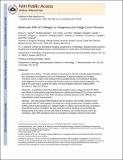Molecular MRI of collagen to diagnose and stage liver fibrosis
Author(s)
Fuchs, Bryan C.; Wang, Huifang; Yang, Yan; Wei, Lan; Polasek, Miloslav; Schühle, Daniel T.; Lauwers, Gregory Y.; Parkar, Ashfaq; Tanabe, Kenneth K.; Caravan, Peter; Sinskey, Anthony J; ... Show more Show less
DownloadSinskey_Molecular MRI.pdf (1.261Mb)
PUBLISHER_CC
Publisher with Creative Commons License
Creative Commons Attribution
Terms of use
Metadata
Show full item recordAbstract
Background & Aims:
The gold standard in assessing liver fibrosis is biopsy despite limitations like invasiveness and sampling error and complications including morbidity and mortality. Therefore, there is a major unmet medical need to quantify fibrosis non-invasively to facilitate early diagnosis of chronic liver disease and provide a means to monitor disease progression. The goal of this study was to evaluate the ability of several magnetic resonance imaging (MRI) techniques to stage liver fibrosis.
Methods:
A gadolinium (Gd)-based MRI probe targeted to type I collagen (termed EP-3533) was utilized to non-invasively stage liver fibrosis in a carbon tetrachloride (CCl[subscript 4]) mouse model and the results were compared to other MRI techniques including relaxation times, diffusion, and magnetization transfer measurements.
Results:
The most sensitive MR biomarker was the change in liver:muscle contrast to noise ratio (ΔCNR) after EP-3533 injection. We observed a strong positive linear correlation between ΔCNR and liver hydroxyproline (i.e. collagen) levels (r = 0.89) as well as ΔCNR and conventional Ishak fibrosis scoring. In addition, the area under the receiver operating curve (AUR0C) for distinguishing early (Ishak ⩽3) from late (Ishak ⩾4) fibrosis was 0.942 ± 0.052 (p <0.001). By comparison, other MRI techniques were not as sensitive to changes in fibrosis in this model.
Conclusions:
We have developed an MRI technique using a collagen-specific probe for diagnosing and staging liver fibrosis, and validated it in the CCl4 mouse model. This approach should provide a better means to monitor disease progression in patients.
Description
Available in PMC 2014 November 01.
Date issued
2013-11Department
Harvard University--MIT Division of Health Sciences and Technology; Massachusetts Institute of Technology. Department of BiologyJournal
Journal of Hepatology
Publisher
Elsevier
Citation
Fuchs, Bryan C., Huifang Wang, Yan Yang, Lan Wei, Miloslav Polasek, Daniel T. Schühle, Gregory Y. Lauwers, Ashfaq Parkar, Anthony J. Sinskey, Kenneth K. Tanabe, and Peter Caravan. "Molecular MRI of collagen to diagnose and stage liver fibrosis." Journal of Hepatology 59:5 (November 2013), pp. 992-998.
Version: Author's final manuscript
ISSN
01688278